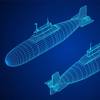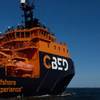Conbit Installs Shelter and Helideck Offshore Libya
The Libyan joint venture of Total and NOC, Mabruk Oil Operations, awarded Conbit a several million dollar contract for the installation of an emergency shelter and helideck on their BD-1 offshore platform
Mabruk Oil Operations ordered a shelter and helideck from a Dutch manufacturer in 2012. The contract involved delivery Free on Board Rotterdam. From this point, Conbit was assigned to arrange transport to Libya and installation on the BD-1 platform, off the coast of Libya. The project was awarded in two parts. The engineering contract was awarded in April, while the transport and installation contract was awarded at the beginning of September 2013, just three weeks before the scheduled transport date.
A team of eight engineers worked throughout the summer to prepare all the required documentation for the project. As with many of Conbit’s project teams, it included a mix of structural engineers, project engineers and draftsman. The combination of these skills is necessary to cover all the aspects of such an operation.
During the early engineering stages, the feasibility was explored and a structural analysis of the existing platform was performed. The results of both were positive and formed the basis for the initial design. The first plan presented by Conbit met with the approval of the client and supplier of the two modules. Three months later, the detailed engineering was finished. Now the transport vessel could be selected.
During the summer, representatives from Conbit and Mabruk met and reached a commercial understanding regarding the transport and installation phase. It was decided that Conbit would be responsible from the moment when the modules were on board a seagoing vessel, selected and contracted by Conbit, until the modules were installed on the BD-1 platform. Mabruk decided that the project should start at the Port of Rotterdam Authority, where the manufacturers of the modules would deliver.
During the first week of October, the M/V Industrial Kelly picked up the emergency shelter and the helideck. This vessel had been contracted by Conbit from Intermarine. The vessel has its own cranes, which would be valuable when unloading in Tripoli. The modules were lifted on two levels of the 130 meter long vessel. The vessel arrived in Tripoli harbor right on time in the middle of a public holiday week. Despite the holiday, the client managed to organize an efficient unloading slot in the harbor and customs schedule.
The first crew to arrive in Libya embarked on a site survey. The four-man crew spent seven days on the platform, during which they performed a dimensional verification and marked the locations where pad eyes were required.
A couple of days before the arrival of the emergency shelter and helideck in Tripoli, the second crew travelled to the BD-1. At the same time, half of the construction equipment was transported in offshore containers via Italy directly to the offshore location on the ASSO 31 supply vessel. This supply vessel had been rented by Mabruk for the duration of the project. The customs authority and a Conbit representative were present on the platform when this shipment arrived and the necessary formalities were completed. The second shipment of construction equipment would arrive a week later on the platform.
Immediately after the second crew arrived at the platform, the preparation works started. Scaffolding technicians started to place overboard scaffolding and perform the first welding activities. At the end of the first week on board, the crew managed to install all the winch, sheave and jacking frames and complete most of the preparatory welding. One week of further preparations was required before the emergency shelter could be lifted. During these activities, a small forklift brought onsite by Conbit proved very useful. This was equipped with a small lift boom and fitted into a 20” offshore container.
At the same time, the shore team on the quayside prepared the supply vessel. The works included the welding of D-Rings on the deck of the Almisan supply vessel. Besides the physical work, the paperwork was completed by the onshore team prior to the day of load out on the quayside. The final step on shore was to mobilize a 250-metric-ton crane, which was required to load the emergency shelter onto the supply vessel.
The lifting of the emergency shelter was scheduled for October 30, when all the required manpower would be on board. Besides the Conbit team, the GL Marine Warranty Surveyor, Mabruk and Total representatives would also be present on the BD-1 platform. The weather conditions should also meet the criteria for the lift. If all the signs were on green, the Almisan supply vessel would leave Tripoli to be under the platform four hours later.
Update after October 30:
The weather was looking hopeful on the morning of October 30, so it was decided that the supply vessel bearing the emergency shelter could leave the port of Tripoli. It arrived at the DB-1 platform early in the morning. All the load tests were successfully completed and the green light was given to perform the lift of the new module.
With such a lift, the first few meters are critical. The waves move the vessel up and down, a movement which is independent from the lifting configuration on the platform. Once the lift begins, the load’s centre of gravity moves below the lift point. This is observed by a vertical lift line, but even the smallest deviation can swing the load. The skills of the winch operator and the captain of the vessel were crucial to place the emergency shelter exactly below the lift point. Once the lift line is vertical, the winch operator decides when to start lifting. Because the waves move the load up and down, the lift needs to start at the top of a wave. If the winch operator cannot start the lift at this precise moment, the vessel might rise and hit the load from the bottom. The winch operator must also lift at the top of the wave to prevent the load from slamming the side walls of the vessel if it starts to swing.
The required speed is precisely the reason why Conbit uses very fast lift winches. These can lift at a rate of 36 meters a minute with a capacity of 15 metric tons. For this project, two of these winches were deployed. The winches are operated by a diesel hydraulic powerpack, making the lifting configuration independent from the offshore platform utilities.
The last part of the lift was performed by hydraulic strandjacks. These were positioned on top of custom-made jack frames and gradually took over the load from the lift winches. The secondary lift lines attached to the strandjacks performed the last part of the lift until the emergency shelter was in its final position. At the end of the day, the emergency shelter was secured in its final position.
The next day, the team removed the winches from the weather deck and assembled scaffolding to the side of the emergency shelter. This scaffolding provided the welders with the access they needed to weld the interface connections. During this work, the weather deck was cleared for the next major activity.
The helideck installation started with the assembly of the support frame. This frame would serve as the foundation of the helideck. On November 1, the support frame was installed and the helideck pancakes were loaded. The pancake was supplied in two halves; two halves are easier to transport and one half was already nearing the maximum capacity of the deck crane of the BD-1 platform. The following day, the ASSO 31 transported the north pancake half offshore. During the journey, Conbit performed a load test on the deck crane. When the ASSO 31 arrived, the pancake half was lifted directly from the supply vessel onto the support frame. Two days later, the same process was repeated for the other helideck half.
The complete helideck and support frame had to be skidded into its final position, as the deck crane was unable to lift the pancake halves at this location. After the skidding, the work was completed.
We can look back at a successful project. The client supported Conbit’s alternative approach. The combination of solid engineering and a competent implementation team formed the basis for this success. During the actual implementation, we definitely proved the effectiveness of the concept. We thank all partners who contributed to this project. We would also like to express our appreciation to the client’s team for their support and cooperation what was a challenging project in many ways.











